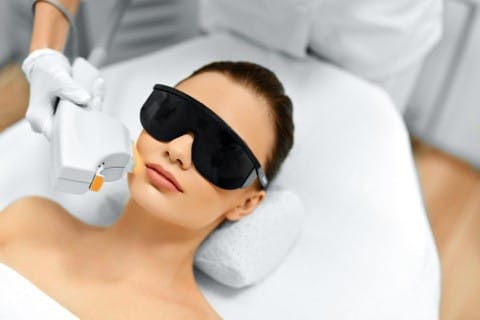
Laser Services
Intense Pulsed Light Therapy
Intense pulsed light (IPL) or flash lamp therapy is a non-invasive and non-ablative treatment that uses high intensity pulses of visible light to improve the appearance of the following skin problems:
Vascular lesions including spider angiomas, port wine stains, broken facial veins, rosy cheeks, rosacea and red thread veins of the legs, freckles and age marks. And also removal of unwanted dark hair.
The procedure of rejuvenating aged skin is referred to as photorejuvenation and requires a series of IPL treatments.
IPL may also be helpful for mild to moderate acne.
How does it work?
IPL systems work on the same principles as lasers in that light energy is absorbed into particular target cells with color (chromospheres) in the skin. The light energy is converted to heat energy, which causes damage to the specific target area. IPL systems are different to lasers in that they deliver many wavelengths (or colors) in each pulse of light instead of just one wavelength. Most IPL systems use filters to refine the energy output for the treatment of certain areas. This enhances penetration without using excessive energy levels and enables targeting of specific chromospheres (these are skin components that absorb light).
IPL therapy is considered a non-ablative resurfacing technique, which means that it targets the lower layers of skin (dermis) without affecting the top layers of skin (epidermis). The results are not as dramatic as ablative resurfacing where both the dermis and epidermis are injured to produce a much more noticeable overall outcome. The advantage of IPL therapy is its minimal downtime – a patient can often have the procedure done in their lunch break and return to work immediately afterwards.
Contra-indications
Certain skin conditions, health irregularities, and medications can impact whether it is safe for a person to receive a light based hair removal treatment. This list applies to both IPL and conventional laser treatments.
- Recent use of depilatory creams or sprays
- Recent waxing, tweezing, or sugaring
- Contagious skin diseases: not always contraindicated but require
Special preparation
- Herpes I and II in the area to be treated: not always contraindicated but requires special preparation
- Skin trauma, lesions, sores or open wounds
- Keloid or hypertrophic scarring
- Moles or skin cancer: treatment can blanch skin marks, making melanoma difficult to detect
- Sunburn
- Suntan, real or fake: hyper stimulates melanin in skin which provides a confusing target for light
- Epilepsy or other seizures potentially caused by flashing light
- Polycystic Ovarian Syndrome (PCOS): condition needs to be normalized with medication before treatment
- Hyperthyroidism: condition needs to be normalized with medication before treatment
- Breastfeeding and pregnancy: increased hormone levels greatly decrease treatment efficacy
- Hirsutism: not contraindicated but will require a greater number of treatments
- Tattoos or permanent makeup in area to be treated
- Photo-sensitizing topical creams or medication: Tetracycline, Minomycin, Doxycycline, St John’s Wort, any citrus







